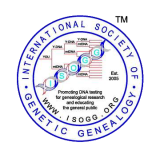Lethal alleles
From ISOGG Wiki
Alleles that cause an organism to die are called lethal alleles, where the gene involved is an essential gene. When Mendel's Laws were rediscovered, geneticists believed that mutations would only alter the appearance of a living organism. However, it was discovered that a mutant allele could cause death. When an essential gene is mutated, it can result in a lethal phenotype. If the mutation is caused by a dominant lethal allele, the homozygote and heterozygote for the allele will show the lethal phenotype. If the mutation is caused by a recessive lethal allele, the homozygote for the allele will have the lethal phenotype. Most lethal genes are recessive.
Examples of diseases caused by recessive lethal alleles are cystic fibrosis, Tay-Sachs disease, sickle-cell anemia, and brachydactyly. Huntington's disease is caused by a dominant lethal allele and even though it is not described as lethal, it is invariably lethal in that the victim experiences gradual neural degeneration and mental deterioration for some years before death occurs. One coat color of ranch foxes is caused by a recessive lethal gene. This gene causes a death if both recessive alleles are possessed by the same individual.
Recessive lethal alleles do not cause death in the heterozygous form because a certain threshold of protein output is maintained. In the homozygous form, the protein output does not meet the threshold, causing death.
